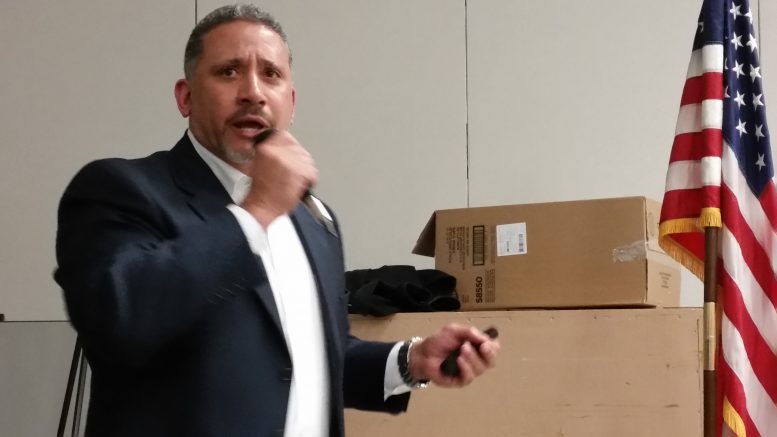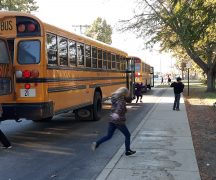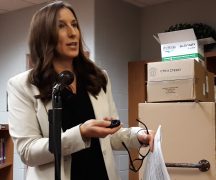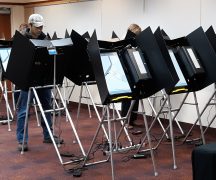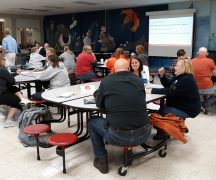By JAN LARSON McLAUGHLIN
BG Independent News
A school taxation expert hired to bring clarity about Bowling Green City Schools funding sources for the new school proposal tried to clear up the muddy issue Thursday evening.
Citizens packed into the middle school cafeteria, and two police officers were on hand to make sure the meeting went smoothly.
David Conley, president of Rockmill Financial, specifically tried to answer whether or not the school district could use income tax instead of property tax for its $72 million building project to consolidate the elementary schools plus add onto and renovate the high school.
His simple answer was – “it’s complicated.”
“In my opinion, what is on the ballot is the best option for the community,” Conley said.
“A property tax is more affordable to most taxpayers than an income tax,” he said of the issue on the May 8 ballot. “Property tax spreads the cost to more taxpayers.”
However, that answer was also complicated, since his statement holds true for the first 10-15 years, when tax statistics from the district show an income tax would then be better.
Conley also added another “big ‘ole asterisk.”
“The agricultural community is really getting hit with this,” he said.
“But my conclusion is that the bond issue right now is the most equitable and fair for the community,” he said.
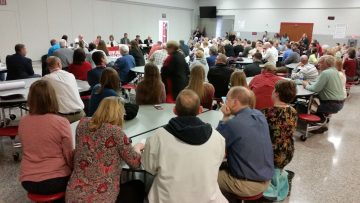
Middle school cafeteria
District officials have said that income tax cannot be used for long-term building projects. More school districts are turning to income tax revenue for building projects, Conley said. However, even that is complicated. Districts can only use income tax for bond issues if they are eligible to get some state facilities funding. There is another option for using earned income tax – but that can’t be enacted by districts that have traditional income taxes in place, which Bowling Green has.
Residents looking for black and white answers disregarded Conley’s complicated explanations.
“We have been misled,” Bud Henschen said about the board’s decision to go for a property tax.
“There’s no way for you to continue to lie to the public,” Richard Chamberlain said to the board as he referred to a letter from the Ohio Facilities Construction Commission.
However, after the meeting, Conley said much of the information presented by Chamberlain in the letter was not as cut and dry as it appeared. Once again, it was more complicated.
Since Bowling Green City Schools ranks 519th of 609 districts for possible state facilities funding, the likelihood is very low that it can access those funds. Only about eight schools get funded a year, meaning BG would be in line many years.
“It’s going to take forever, if the program is still around,” Conley said.
It’s possible the state could give the district 15 percent back if it builds to state standards, he added. “Every dollar’s going to count down the road,” but the district would have to foot the construction costs.
Conley also presented an overview of the school district’s tax situation.
“Your taxes are fairly low compared to other school districts in the region,” he said.
Meanwhile, the local economic and demographic indicators show some troubling trends. From 2010 to 2016, the median family incomes and median home values have dropped in the district.
“Most of you haven’t gotten a raise,” Conley said. “Which matters, because the school district is asking you to pay more.”
The number of housing units with mortgages is down, indicating older homeowners. And renter occupied housing has grown to 53.7 percent, compared to a state average of 24 percent.
The average family size has increased, with the number of people with bachelor’s degrees has decreased. The number of people in poverty has grown 12 percent in the district.
“Those are all pointing to challenges in terms of earning,” Conley said. “The community is showing signs of stagnation.”
Conley also pointed out that improving school facilities can help a struggling community.
However, that takes money, and in this case, it will take a lot of money from the farming community which has seen a huge jump in property valuation. “It’s a significant blow,” he said.
The latest tax statistics show a decrease in farm valuations and a bump up in residential values.
The proposed property tax would collect 59 percent of its total revenue from homeowners, and 41 percent from agriculture and businesses. Most of the largest property taxpayers are apartment complex owners, he said. The notion that property taxes don’t get passed on to renters is just not true, he added.
Income taxes, Conley said, are only paid by residents of the district. Businesses are exempt. In order to pay for the school building plans, the district would need a three-quarters percent income tax on top of its existing one-half percent.
Using current tax affordability statistics, Bowling Green School District now ranks fifth best of the 16 area school districts. The spending per pupil here is below the state average, Conley said.
If the voters passed the property tax, the affordability would slip to 10th of 16. An income tax would cause it to slip even further to 15th of 16 area school districts.
Steve Bateson complimented Conley on his presentation and said it would have been helpful to have this information last year when the issue first went on the ballot. Bateson said the bond issue has caused great divisiveness.
“Friends and neighbors have difficulty talking about it,” he said.
Conley will try to make the picture even clearer during a public meeting planned for April 26, at 6:30 p.m., in Conneaut Elementary School. When asked by a citizen about his fee, Conley said the district was paying him $40,000 for the year.
“You need good advice,” he said.
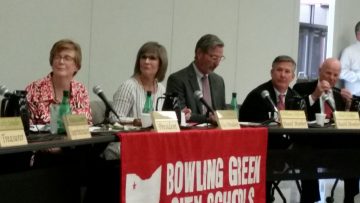
Bowling Green Board of Education
Prior to Conley’s presentation, School Board President Jill Carr explained the reasoning behind the school board request for the same issue that voters turned down last November.
“We are committed to put the best plan in front of our community,” she said. When asked last year, what the board would do if the levy failed, the answer was that the consolidated elementary remained the best solution to provide equity of resources, class sizes and opportunities.
“We have lived up to our word,” Carr said. “They deserve the same opportunities our neighboring school districts are enjoying.”
To allow the public to get a better look at the condition of the aging school buildings, tours will be offered on April 28, from 10 to 11:30 a.m. in the high school, 12 to 1:30 p.m. in Kenwood Elementary, and 2 to 3:30 p.m. in Conneaut Elementary.
Citizens were also given a chance to express their feelings at Thursday’s board meeting.
Barb Keller talked about the need to build new rather than trying to renovate 52-year-old buildings to meet today’s technology needs for students.
“It’s going to cost money to educate our students,” she said. “It’s an investment in the future. Somebody invested for us and it’s our turn. Let’s not be so damn selfish.”
Bowling Green City Council member and local Realtor Sandy Rowland said the district needs new schools.
“The best thing we can do is invest in our schools now,” she said.
Rowland talked about trying to sell homes in Bowling Green to families with children.
“We’re not going to attract them with 52-year-old buildings,” she said. When she shows families the Bowling Green schools, “they say, ‘Take me to Perrysburg.’”
Diane Vogtsberger, who taught 39 years in Bowling Green schools, said the building plan is ambitious, but “one that has been delayed far too long.” The students deserve new learning environments that will help them compete.
Vogtsberger spoke of some citizens’ concerns about the loss of neighborhood schools. She said each wing of the new elementary will be the size of the current elementaries. And she echoed statements made at previous meetings about the very small number of children who walk or bike to school now.
Kathleen Pahl, who supports the neighborhood school concept, balked at the idea that citizens opposed to the levy don’t support the schools.
“We all care,” she said. “Everyone wants schools to be improved.”
Steve Bateson questioned that district’s rationale of building a new gym and locker room, costing an estimated $4 million, with the plan of making money from the facility. “Generating revenue is a falsehood for this.”
Dean Smith took a “No School Realignment” yard sign from 2004 to the podium to stress that he intends to continue fighting against “transients” who want to change the schools.
“Leave our elementary schools alone,” Smith said.
High School Principal Jeff Dever said he believed renovating the elementaries would be “throwing good money after bad.”
He also said the high school needs renovations – including those for safety concerns.
“I can’t defend 17 entrances,” he said, noting that the high school was not built for today’s security needs.
“I think it’s time to take our buildings into the 21st century,” Dever said.
Ann McCarty, executive director of teaching and learning, talked about her 20-plus years in education – in poor and rich districts.
“Facilities matter,” she said.
Grant Chamberlain accused the school board of committing a “violation of our public trust.” He said the permanent improvement money used for the addition currently being put on the middle school could have been used for building maintenance.
“You could be repairing our buildings without adding any tax to us,” he said, accusing the board of “subversive and immoral behavior.”
Richard Strow said the board has failed to live up to the public’s trust, financial responsibility and transparency, by sitting on $13 million in the bank and asking for more from the taxpayers.
Parent David Codding said and his wife support the levy and the school board. He suggested that rather than attacking school board members, that those opposed run for board seats instead.
Rachel Fletcher, a teacher at Crim, said she is well acquainted with the inequities at the district’s elementaries.
“Renovating our current buildings will not solve that problem,” she said.
She mentioned that the library at Crim recently had to be cut for classroom space, that the Kenwood and Conneaut PTOs have more resources, and that 90 percent of the district’s teachers support the levy.
Parent Matt Lyons voiced his support for the levy and consolidation of the elementaries. “Pooling resources makes sense,” he said.
Zeb Kellough, curriculum coordinator, said his third grade son has asked him “why don’t we have a school like that,” referring to a Perrysburg school.
“This is all about the students,” Kellough said. “It’s our responsibility as educators to help them see a brighter future.”

